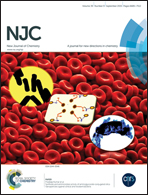Structural diversification and photocatalytic properties of zinc(ii) polymers modified by auxiliary N-containing ligands†
Abstract
Four new coordination polymers, {[Zn(bismip)]·2H2O}n (1), {[Zn2(bismip)2(4,4′-bipy)]·2H2O}n (2), {Zn2(bismip)2(phen)}n (3) and {[Zn(bismip)(bimb)]2·2H2O·DMF}n (4) (H2bismip = 5-(1H-benzoimidazol-2-ylsulfanylmethyl)-isophthalic acid, 4,4′-bipy = 4,4′-bipyridine, phen = 1,10-phenanthroline, bimb = 4,4-bis(1-imidazolyl)bibenzene) were synthesized under solvothermal conditions. All these compounds were characterized by elemental analysis, IR spectroscopy, thermal analysis, powder X-ray diffraction and single-crystal X-ray diffraction. Compound 1 features a two-dimensional (2D) binodal (3,6)-connected kgd network with (43)2(46·66·83) topology. 2 exhibits two-fold interpenetrating 3D architecture with a (4·82)(42·84) Schläfli symbol in which 2D layers are interlinked by 4,4-bipy ligands. In 3, the [Zn4(bismip)4] and [ZnO4N2] units are interconnected, affording a binodal 3D (3,4)-connected network with the Schläfli symbol (83)(86). 4 is a 2D (3,4)-connected coordination network with (42·6)(42·63·8) topology. The photoluminescence properties and photocatalytic properties of these compounds were also investigated.


 Please wait while we load your content...
Please wait while we load your content...